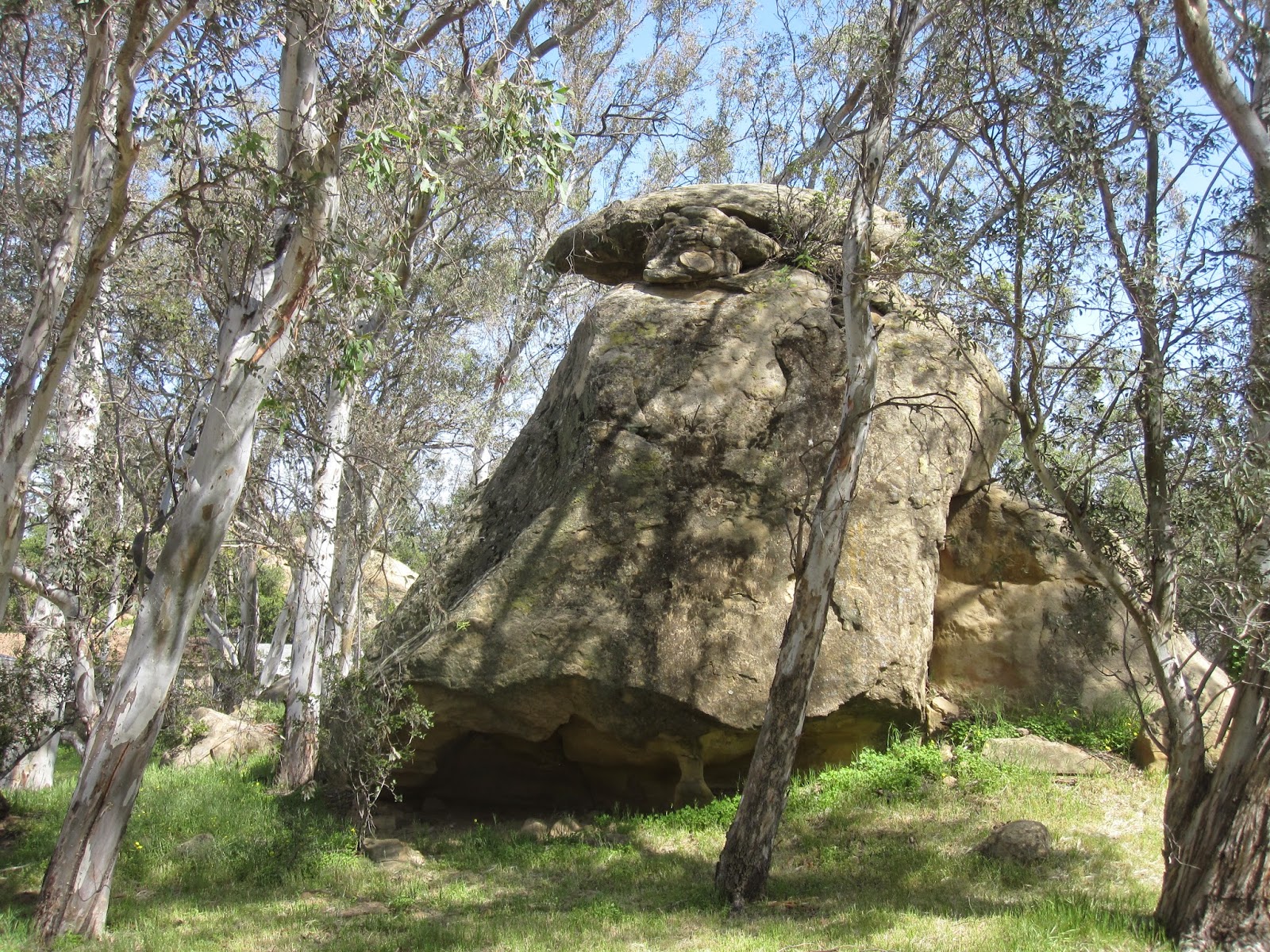Hugh O'Brian
Hugh O'Brian starred as frontier Marshal Wyatt Earp for six seasons on the TV Western "The Life and Legend of Wyatt Earp," from 1955-1961. It was steady work, with the ABC series churning out 229 episodes in that span, and O'Brian spent much of his on-camera time on the Iverson Movie Ranch in Chatsworth, Calif.
"The Life and Legend of Wyatt Earp" (1960)
Here's a shot of O'Brian in Iverson's Eucalyptus Grove, with Cooper Rock in the background at top left. The shot comes from an episode of the series titled "The Doctor," which first aired Oct. 4, 1960, during the show's final season.
The two key rocks in the previous screen shot are highlighted here. The larger rock is Cooper Rock, named for Gary Cooper after he built Iverson's Western town nearby for Cooper's 1945 feature film "Along Came Jones." Cooper Rock was destroyed in the mid-1960s when the Indian Hills Mobile Home Village was built, but the smaller rock in front of it, which some film location researchers now call the Cooper Locator Rock, survived and remains in place today.
Cooper Locator Rock as it appears today.
(The rock formation in the background is the Pirate Ship.)
Today the Cooper Locator Rock helps pinpoint where Cooper Rock was once located (hence, the name). The locator rock survived because it's just south of the wall marking the southern boundary of the mobile home park, which is visible in the above shot. The locator rock remains in its spot in the surviving portion of the Eucalyptus Grove on the Lower Iverson. The much larger Cooper Rock wasn't so lucky, as it straddled two properties when the land was subdivided and it had to be destroyed so that the property on the north side could be filled with mobile homes.
Indian Hills Mobile Home Park — movie rocks in the swimming pool area
Some sections of what is now the mobile home park, including the swimming pool area, remain populated by once-famous movie rocks, such as those seen in the photo above.
"The Living Bible" (1952)
The rocks seen in the swimming pool shot above can also be seen in the 1952 production "The Living Bible." The above screen shot from the production shows Jesus and his followers walking past those same rocks.
In case you're having trouble matching up the recent shot of the swimming pool rocks with the shot from the 1952 Bible movie, the above composite photo points out one of the most prominent markers appearing in both shots.
Back to Hugh O'Brian and "Wyatt Earp," this angle from the sequence shown at the top of this post reveals what's going on in front of Wyatt at the time — he's at the Grove Relay Station, where he's being kept at bay by a woman holding a rifle on him. The "Wyatt Earp" TV show filmed some nice footage of the Grove Relay Station around this time, which is fortunate for us as historians and Western location fans because the building didn't leave behind the kind of prominent footprint in movies and old TV shows that its cousin the Saddlehorn Relay Station left behind.
"The Life and Legend of Wyatt Earp" (1960) — Grove Relay Station
Another shot of Hugh O'Brian from the "Wyatt Earp" episode "The Doctor" shows Earp with one of the Eucalyptus Grove's many impressive movie rocks in the background, at top right. The Grove was used as a production location fairly regularly during the filming era at Iverson, and while it has been diminished in scope in the intervening years, a good chunk of the Grove still survives.
Here's what that same movie rock looks like in more recent times. The angle is not exactly the same as in the "Wyatt Earp" shot, but readers may spot similarities between the two shots when it comes to the shape of the rock — particularly near the bottom of the rock. Note that many of the Grove's eucalyptus trees continue to flourish.
Hugh O'Brian also worked the Upper Iverson during his tenure as TV's Marshal Wyatt Earp. In this shot from "The Truth About Old Man Clanton," O'Brian appears in front of the Upper Ranch's Prominent Rock, also known as Medicine Rock, visible at top left.
O'Brian was nominated for an Emmy in 1957 for his performance in "The Life and Legend of Wyatt Earp," which is remembered as one of the better Western TV series of its era. The series played a significant role in the evolution of the TV Western from its early days as a format primarily for kids — "The Lone Ranger," "The Cisco Kid" and "Hopalong Cassidy" are among the many examples — into a later, more mature version of the TV Western typified by "Gunsmoke," "The Virginian," "Bonanza," "The Big Valley" and others.
Please try out the Amazon links below if you're interested in locating DVD copies of "The Life and Legend of Wyatt Earp":













Belum ada tanggapan untuk "Hugh O'Brian — TV's Wyatt Earp — brings the Wild West's most famous lawman to the Iverson Movie Ranch"
Posting Komentar